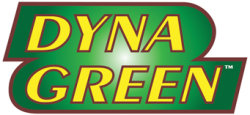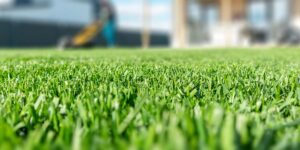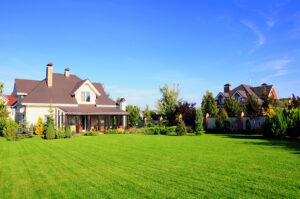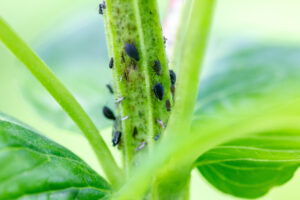To help combat the turf diseases listed below, we recommend to use Dyna Green Eagle and Dyna Green T-Methyl. Use these in alternate uses two weeks apart for best control. Start applying when overnight temperatures and humidity equal 150. That is the time when these diseases start multiplying and start doing damage long before symptoms show up. Use Eagle first which is a systemic and will protect the plant from getting the disease. If conditions persist use T-methyl which is a contact and will help kill the disease that is there. Alternating, these two uses different chemistry and prevents disease resistance to one or the other.
| Disease | Infection Sign and Controls |
|---|---|
Anthracnose (Colletotrichum cereal)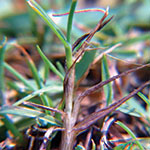 | Hosts: Creeping Bentgrass, Annual Bluegrass Time: May-September Anthracnose has two forms- foliar blight and basal rot. The foliar form develops as yellow/orange freckle-like spots or 1’ patches. Foliar blight starts on the tip of older leaves. The basal rot attacks leaf sheaths, crowns, and stolons. Black spiny fruiting structures can be seen with a hand lens. Low cutting heights, high traffic, malnutrition and lack of water increase severity. |
Brown Patch (Rhizoctonia solani)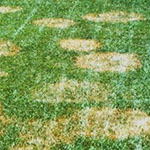 | Hosts: Creeping Bentgrass, Kentucky Bluegrass, Fescues, Ryegrasses Time: May-September In taller cut grasses, rough circular patches that are brown/tan/yellow may be 6” to several feet. Tan lesions with a dark brown border are evident on leaves. During high humidity mycelia strands can be seen growing between leaves. Smoke ring can be seen on putting greens. |
Large Patch (Rhizoctonia solani)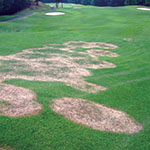 | Hosts: Bremudagrass, Centipede, Seashore Paspalum, St. Augustine, Zoysia Time: August-May Large patch is a new name for an old disease. Formerly known as brown patch, it was distinguished as separate because it affects warm-season grasses and occurs at different times of the year than brown patch on cool-season grasses. Large (2-10’) yellow/tan/straw colored and circular patches develop when temperatures are cool and moist. An orange ring can be seen on the edge of the patches. Leaf sheaths and crowns have lesions. |
Dollar Spot (Scleroinia homeocarpa)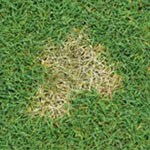 | Hosts: ALL Time: February-November Foliar blight starts on the tip of older leaves. The basal rot attacks leaf sheaths, crowns, and stolons. Black spiny fruiting structures can be seen with a hand lens. Low cutting heights, high traffic, malnutrition and lack of water increase severity. |
Necrotic Ring Spot (Leptosphaeria korrea)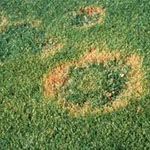 | Hosts: Kentucky Bluegrass, Fescues, Annual Bluegrass Time: June-September This is a perennial disease of KYB. Circular or doughnut-shaped patches of dead grass develop in late summer. Usually a problem on 3-year old sodded lawns that are growing on subsoil or a different soil type. The fungus attacks the roots and crowns. Recovery is often very slow. |
Leaf Spot & Melting out (Drechslera poae, Bipolaris cynodontis)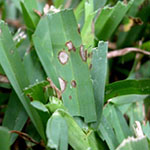 | Hosts: Creeping Bentgrass, Annual Bluegrass Time: Leaf Spot: March-June; Melting out: September-November In KYB, this disease is active in warm/humid weather but in B it is active when it is cool/wet. Leaf spots are seen at the beginning of the disease cycle and this will lead to a melting out of the individual sprigs. Lesions have a yellow halo. Dead plants form irregular patterns. |
Pythium Blight (Pythium aphanidermatum)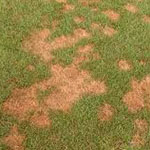 | Hosts: Creeping Bentgrass, Kentucky Bluegrass, Fescues, Ryegrasses Time: June-August Small, sunken, circular patches up to 1’ in diameter are formed during hot/humid/wet weather. Leaves become matted, orange/gray and greasy looking. Mycelium can be seen growing from leaf to leaf. This disease moves quickly and often with water. |
Red Thread (Laetisaria fuciformis)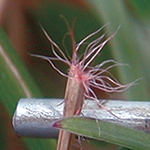 | Hosts: Kentucky Bluegrass, Fescues, Ryegrasses Time: March-June Circular to irregular patches develop. Cottony mycelium is usually visible. Red strands/threads grow from the affected leaves. Small tufts of pink fuzzy mycelium may also be seen during wet/humid weather. |
| Rust (Puccinia spp.)  | Hosts: Kentucky Bluegrass, Fescues, St. Augustine, Zoysia Time: March-June and Sepetember-November Early on small yellow flecks develop in stand. As the flecks turn into pustules that burst the orange spores are released often being apparent on white shoes. Clouds can be seen on heavily infested stands. |
Spring Dead Spot (Ophiosphaerella korrae & O.herpotricha)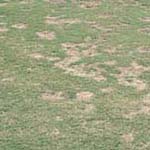 | Hosts: Creeping Bentgrass, Annual Bluegrass, Kentucky Bluegrass, Fescues Time: June-September In the summer, circular patches or rings appear (6” to 3’). Turf usually wilt, grow poorly and sink into patch eventually turning yellow then gray. Roots, crowns, rhizomes are black with mycelia. Remain active for years and grow outwards. |
Summer Patch (Magnaporthe poae)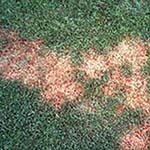 | Hosts: Bermudagrass, Zoysia Time: April-September Circular patches develop in spring (6” to several feet). Roots, rhizomes and stolons usually are black from the fungus. Often less susceptible plants invade collapsed patch. |
Take All (Gaeumannomyces graminis avenae)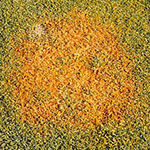 | Hosts: Creeping Bentgrass Time: June-September Circular, orange/tan patches appear in cool/wet springs. Droughty periods increase severity of patches in summer and fall. Alkaline soils (pH>7) favors this disease. |
